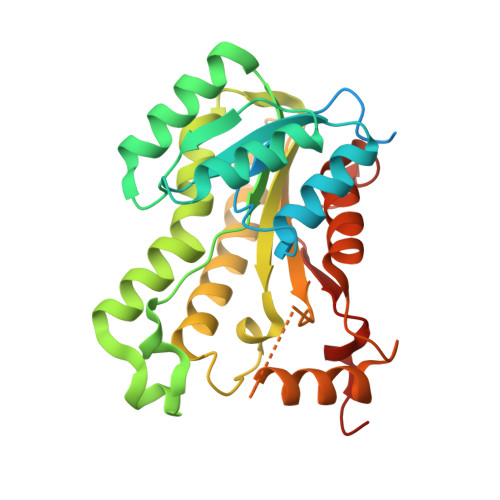Crystallographic insights into the structure-activity relationships of diazaborine enoyl-ACP reductase inhibitors.
Jordan, C.A., Sandoval, B.A., Serobyan, M.V., Gilling, D.H., Groziak, M.P., Xu, H.H., Vey, J.L.(2015) Acta Crystallogr F Struct Biol Commun 71: 1521-1530
- PubMed: 26625295
- DOI: https://doi.org/10.1107/S2053230X15022098
- Primary Citation of Related Structures:
5CFZ, 5CG1, 5CG2 - PubMed Abstract:
Enoyl-ACP reductase, the last enzyme of the fatty-acid biosynthetic pathway, is the molecular target for several successful antibiotics such as the tuberculosis therapeutic isoniazid. It is currently under investigation as a narrow-spectrum antibiotic target for the treatment of several types of bacterial infections. The diazaborine family is a group of boron heterocycle-based synthetic antibacterial inhibitors known to target enoyl-ACP reductase. Development of this class of molecules has thus far focused solely on the sulfonyl-containing versions. Here, the requirement for the sulfonyl group in the diazaborine scaffold was investigated by examining several recently characterized enoyl-ACP reductase inhibitors that lack the sulfonyl group and exhibit additional variability in substitutions, size and flexibility. Biochemical studies are reported showing the inhibition of Escherichia coli enoyl-ACP reductase by four diazaborines, and the crystal structures of two of the inhibitors bound to E. coli enoyl-ACP reductase solved to 2.07 and 2.11 Å resolution are reported. The results show that the sulfonyl group can be replaced with an amide or thioamide without disruption of the mode of inhibition of the molecule.
- Department of Chemistry and Biochemistry, California State University Northridge, Northridge, CA 91330-8262, USA.
Organizational Affiliation:
















